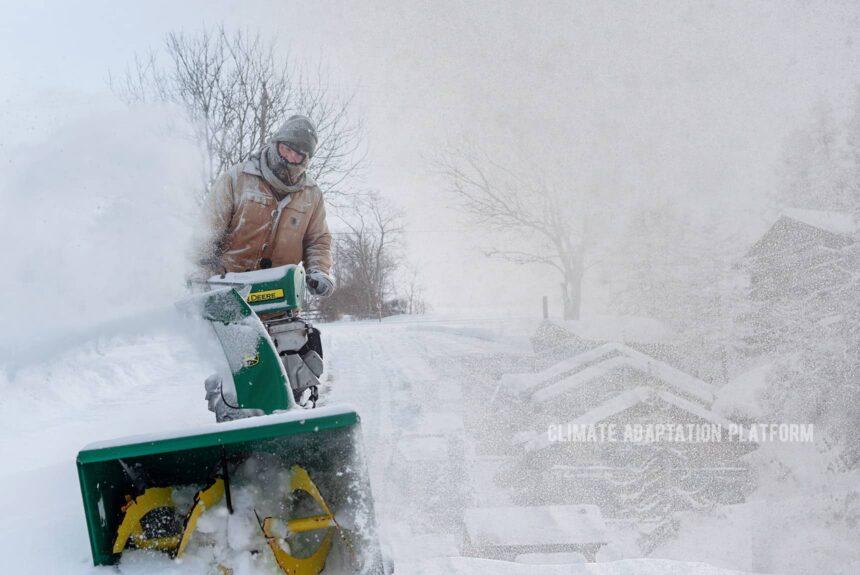Last December, the deep freeze that swept through New York and Ontario was bad and billed as a “once-in-a-generation storm.”
While the links between climate change and extreme weather are becoming more evident, such as intensifying heatwaves, droughts, downpours, and cyclones. A warming planet causing severe winter weather and winter storms can be counterintuitive.
The snow and ice that blanketed parts of the US and Canada resulted in deaths and disrupted lives during the Christmas weekend.
USA Today reported that more than two dozen died in Buffalo during the blizzard over the Christmas weekend and 49 deaths in other parts of the nation as people grapple with severe weather (Pulver, 2022).
BBC also reported the extreme winter storm also caused power outages from Texas to Maine, Quebec, and Ontario provinces, cancellation of classes in several school boards in Ontario, including Toronto, and road closures in some interstate highways, including Western New York and South Dakota, and other disruptions.
According to meteorologists, this is caused by the polar vortex – a mass of freezing Arctic air that moves southward to Canada and the United States. When the cold air reaches Canada and the US, it can clash with the masses of warm air, causing temperatures to dive dramatically, causing a deep freeze in many areas, and the change in pressure creates strong winds.
The collision of freezing air and warm air is what meteorologist calls a “bomb cyclone,” a spinning and intense storm that brings heavy snow or rain and storm surges in coastal areas.
What causes that polar vortex or freezing air to move southward is a topic of debate among scientists. Some believe that the rapid warming of the Arctic – four times faster than any region weakens the polar jet streams, allowing the freezing air to spread downwards.
Environment Canada defines jet streams as “a narrow band of strong winds about 10 kilometres above the Earth, marking the dividing line between warm and cold air masses.”
John Clague, a professor of geosciences at Simon Fraser University in Burnaby, B.C., explains how jet streams can influence extremes in weather.
He said, “the jet stream, which moves from west to east and carries weather systems with it, is moving more slowly than it normally does and seemingly parking itself over an area for a period of time. The mass of cold or hot air that it’s carrying lingers in the atmosphere where it clashes with moisture-laden currents, causing heavy snow or rain” (Alam, 2022).
“This interface between this moist, tempered air at lower latitudes and the cold, drier air– Arctic air– generates snowfall”, he adds (Alam, 2022).
Kent Moore, an atmospheric physics professor at the University of Toronto, says that although it is a contradiction that climate change is producing more intense snowstorms, evidence shows that the warming planet, changing the dynamics of the jet stream, causing to have “larger undulations” which means it could go west to east or can travel north or goes south – pulling the cold Artic air along with it (Alam, 2022).
A study supported the observation that the weakened jet stream, which makes it wavier or more sinuous, causes the polar vortex’s southward movement. However, research is still developing on this subject.
In cities and areas surrounding the lakes, regions, such as Buffalo, New York, has seen a record amount of snow dump – 22 inches of snow on the 23rd of December. A significant contributor to the heavy snowfall is what is known as the “lake effect.”
CBC reports that the lake effect is a rare phenomenon that can only happen in a few places within large enough bodies of water, such as the Great Lakes. They hold 20% of the world’s freshwater and are susceptible to lake effect storms.
The article explains a lake effect: “A lake effect snowstorm occurs only under particular conditions when cold air passes over a relatively warm body of water. The air picks up moisture and heat from the lake, which causes the newly warmed air to rise. High in the atmosphere, the moisture then cools and condenses and starts to fall as snow.”
According to the New York Times article, “Lake-effect snow is expected to increase as the planet warms because lakes will be warmer in winter and will remain unfrozen for longer. At some point, however, average winter temperatures in some areas could rise to the point where snow will diminish and be replaced by lake-effect rain.”
Sources:
Fountain, H. (2022, December 28). A ‘Once in a Generation’ Storm. What’s the Role of Climate Change? The New York Times. Retrieved from https://www.nytimes.com/2022/08/11/climate/arctic-global-warming.html
Pulver, D. (2022, December 28). Climate change won’t make winter storms and blizzards go away. Scientists explain why. USA Today. Retrieved from https://www.usatoday.com/story/news/2022/12/27/buffalo-blizzard-climate-change-extreme-weather-events/10955920002/
Alam, H. (2022, December 24). Canada’s intense snowstorms can be linked to climate change, scientists say. What to know. Global News. Retrieved from https://globalnews.ca/news/9372200/intense-snowstorms-linked-to-climate-change-canada/
Yousif, N. (2022, December 23). Deadly winter storm knocks out power for 1.5m in US and Canada. BBC. Retrieved from https://www.bbc.com/news/world-us-canada-64061588



Leave a Reply